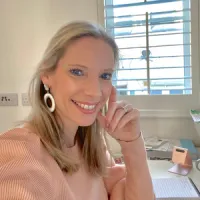Room for More - The Blog

Reframing Challenges
A challenge does not equal failure
How many times do we come up against a challenge or a stumbling block when we’re working towards something and in our brains, we make that challenge or stumbling block mean that we’ve failed because the path to our desired end result wasn’t smooth and clear and without obstacles?
Encountering a challenge isn’t a sign you should stop and give up.
Encountering a challenge is a beautiful opportunity to pause and to reflect on how far we’ve come, what got us this far and what actions will get us over the hurdle and on towards the next phase of the goal plan.
And it might be that you don’t need to implement or employ completely new actions or tools. Maybe it’s a case of simply tweaking what you’re already doing or what you already have so that it’s once again fit for purpose and is robust enough to overcome the challenge.
For example imagine you’re mowing the lawn; the setting you’ve got the blades on will cut the grass down to a certain height and no shorter. But you want the grass a bit shorter than that setting allows. In this case you don’t need to scrap your current lawn mower and go and buy a new one. All you need to do is adjust the blade setting so it’ll give a shorter cut. You’re using your current tool and tweaking it so that it’ll allow you to achieve your desired outcome.
But there will be times when what you’re doing and what you have simply won’t be enough to overcome the challenge you’re facing.
And in these moments take time to be grateful and proud of the fact that you got as far as you did without encountering any hurdles or setbacks with the skill set you currently have.
And then take some time to deep dive into why you’re struggling to overcome the challenge. It could be any number of things which could include:
A lack of knowledge
A lack of manpower
Technological limitations
Geographical limitations
Limiting beliefs
On paper, the first three are the easiest to overcome. You can bridge the knowledge gap by reading a book, or ask someone who already knows how; you could buy a course and learn what you need to know.
If it’s a lack of manpower then you can hire in some assistance to either do what you don’t know how to do, or to do what you don’t have time to do so you free up some of your time.
Again with technological limitations, can you upgrade your current set-up, or download or purchase the software that will allow you to do what you need to do?
I appreciate that some of the above solutions require a financial investment and so you might not be in a position to solve for them immediately, but at least you know WHAT the issue is, how you will go about solving for it and you can therefore make a plan on how you can start to solve it. (This is why I said that on paper they seem to be the easiest problems to solve; the solutions though might not be the easiest to execute)
Limiting beliefs on the other hand can be quite the little madam to overcome. Think of your limiting beliefs as splinters; some are just below the surface and are easy to grab a-hold of and remove but others have been left to lodge themselves deeper under your skin and are harder to deal with. Maybe these ones were uncomfortable at first, or maybe you didn’t even realise when you first got them, but you’ve kind of gotten used to them being there now and, with the passage of time, you’ve just grown accustomed to them and accept them as part of your everyday life.
Limiting beliefs can be exactly the same. The longer you’ve had the limiting belief, the harder it will be to reverse it, or start unbelieving it. You see the more you practice the thought, the more evidence you gather to prove it true. And because you have the evidence to back it up, you think that that thought must be true. But you only have a load of evidence for that thought because that’s what your focus was on; you were unconsciously looking for proof that that thought was true because you were thinking that thought in the first place. It’s a terrible feedback loop to find yourself in. If your focus was on a different thought, you would have collected evidence to back up that thought instead.
And so just as the splinter embedded itself under your skin over a number a days, weeks or even months, that’s what you’re enabling your limiting beliefs to do when you continue to think them; each time you think the limiting thought, you’re effectively pushing it down a bit deeper.
And so the way to start unbelieving the thoughts that do not help you, is to shift your focus to something that does help you; a thought that, once you gather evidence to support the veracity of, will allow you to act, think and show up in ways that are expansive and which allow you go beyond what you thought your limits were. You see it’s a feedback loop that keeps itself going; you think a thought and the act of thinking that thought is a signal to your brain to filter through everything you are presented with and to only focus on the information that supports the thought you are thinking.
This evidence then starts stacking up, and the more evidence you have, the more you think the thought is true, thereby the more likely you are to live your life in accordance with that thought.
So you can see why it is imperative to think thoughts that will help you get to where you want to go. Because what you think, you will gather evidence for, and what you gather evidence for you will convince yourself is real and because you think it’s real you will think it can’t be changed. And so the soundtrack to your life is a thought or thoughts that limit your potential.
Phew! I hope you are still with me because this is some good stuff.
And whilst you can’t just throw money at this in the same way you can pay to hire some help or to upgrade your tech problems, the reward you will gain from understanding how to shift your focus and how to start unraveling your limiting beliefs, can be enjoyed time and time again.
With practice you recognise when you are thinking a limiting belief/thought, and once you know what your limiting beliefs are you can start to shift your focus to a thought that is more helpful.
So what is a limiting belief? It’s a belief you have about yourself/your situation or circumstance that is keeping you stuck, that is stopping you from going after certain things in life or which is preventing you from trying X, Y or Z. An example might be “I’m too shy to go to a networking event”.
The belief that you are too shy might feel true to you, and I’d like to offer this to you: it feels real and true because you’ve spent so long thinking of yourself in this way and so the result is that you have a catalogue of evidence in your mind of times when you consider that you were shy. But just because you have evidence to support the fact you were shy at certain times, doesn’t mean that the evidence to support you not being shy doesn’t exist; it simply means you haven’t asked your brain to look for it and show it to you. So I’d like to ask you to think of at least five times when you weren’t shy. They don’t have to be recent and they don’t have to be “momentous” occasions. At this stage what I am encouraging and inviting you to do, is to get your brain looking for evidence to support a different thought, a thought that better serves you.
Once you start gathering evidence to support the new thought, it’s easier for your brain to believe that that new thought is real and true (because it can supply evidence to support it), and so over time and with repetitive practice, that new thought gradually becomes easier to think, you have less resistance towards it, and eventually it becomes your default way of thinking, and the default way you see yourself.
So as I bring this to a close, I’d like to ask you what limiting belief are you going to kick to the kerb? And what new expansive thought will you start to practice instead?
As always I’d love to hear your thoughts on this; you can reach me over on Instagram roomformorebykelly
I hope you have a lovely day and we’ll catch up next time.
© Copyright 2022 Room For More
